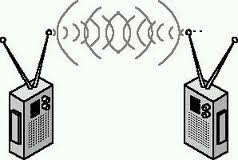TYPES OF SIGNAL
-variety style : TEXT, PICTURE. etc
ANALOG SIGNAL :
Analog signals are signals with continuous values. Analog signals are used in many systems, although the use of analog signals has declined with the advent of cheap digital signals.
Analog systems are less tolerant to noise, make good use of bandwidth, and are easy to manipulate mathematically. However, analog signals require hardware receivers and transmitters that are designed to perfectly fit the particular transmission. If you are working on a new system, and you decide to change your analog signal, you need to completely change your transmitters and receivers.
DIGITAL SIGNAL :
Digital signals are signals that are represented by binary numbers, "1" or "0". The 1 and 0 values can correspond to different discrete voltage values, and any signal that doesnt quite fit into the scheme just gets rounded off.
Digital signals are sampled, quantized & encoded version of continuous time signals which they represent. In addition, some techniques also make the signal undergo encryption to make the system more tolerent to the channel.
DATA FLOW
Simplex, half-duplex and full-duplex connections
There are 3 different transmission modes characterised according to the direction of the exchanges:
A simplex connection is a connection in which the data flows in only one direction, from the transmitter to the receiver. This type of connection is useful if the data do not need to flow in both directions (for example, from your computer to the printer or from the mouse to your computer...).
A half-duplex connection (sometimes called an alternating connection or semi-duplex) is a connection in which the data flows in one direction or the other, but not both at the same time. With this type of connection, each end of the connection transmits in turn. This type of connection makes it possible to have bidirectional communications using the full capacity of the line.
A full-duplex connection is a connection in which the data flow in both directions simultaneously. Each end of the line can thus transmit and receive at the same time, which means that the bandwidth is divided in two for each direction of data transmission if the same transmission medium is used for both directions of transmission.
DATA TRANSMISSION MODES
Serial connection
In a serial connection, the data are sent one bit at a time over the transmission channel. However, since most processors process data in parallel, the transmitter needs to transform incoming parallel data into serial data and the receiver needs to do the opposite.
These operations are performed by a communications controller (normally a UART (Universal Asynchronous Receiver Transmitter) chip). The communications controller works in the following manner:
The parallel-serial transformation is performed using a shift register. The shift register, working together with a clock, will shift the register (containing all of the data presented in parallel) by one position to the left, and then transmit the most significant bit (the leftmost one) and so on:
The serial-parallel transformation is done in almost the same way using a shift register. The shift register shifts the register by one position to the left each time a bit is received, and then transmits the entire register in parallel when it is full.
Synchronous Transmission:
Large volumes of information can be transmitted at a single time with synchronous transmission. This type of transmission involves the simultaneous flow of several bytes of data. Because a large block of data being sent synchronously cannot be interrupted, a synchronized clock is necessary to carefully schedule the transmission of information. This special communications equipment is expensive; but this cost can be made up in part by faster, less expensive transmission of information.
Asynchronous Transmission:
Conversely, asynchronous transmission involves the sending and receiving of one byte of data at a time. This type of transmission is most often used by microcomputers and other systems characterized by slow speeds.








woo...thx lots bout ur information...
ReplyDeleteespecially DATA FLOW...
ble bc blog ko nie tmbah ckt info lam pale aku nie....thanx syg!!
ReplyDeletevery nice....
ReplyDeletesemakin cantik dan menarik.dan dapat memberikan info yg byk..thanks fazira <3